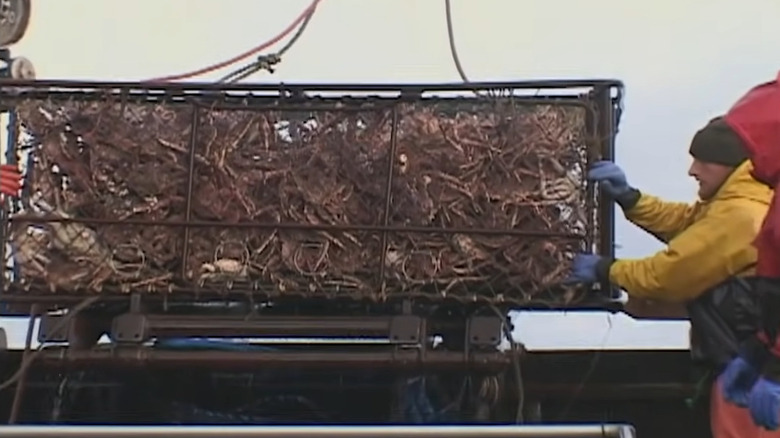Sig Hansen Tried Out A Strange Liquid Bait On Deadliest Catch And Here's What Happened
When it comes to the brave fisherman pushing their vulnerable vessels across the treacherous Bering Sea on Discovery's "Deadliest Catch," it's obvious that the number one goal is to catch some crab. And all the items needed to successfully trap those scrumptious crawlers (not including the superstition of biting off a fish head) are not only essential but expensive. One specific item helps push the expense total to its limit, and that's the bait.
A crabbing boat could have the most pristine solid crab pots encased with the most robust netting, but those valuable crustaceans aren't going anywhere near it without the right bait. Traditionally, according to AlaskanKingCrab, the bait for these crab cages is herring and codfish (which are actually the usual predators of the crab, ironically) chopped up and shoved into a mesh bag that hangs from inside of the trap. The hope is that the fish pieces seep out and attract a steady stream of crabs. In Season 18, Episode 20 ("Frozen"), Sig explains this process. "When you shred it, they [the crab] attack that bag, and little particles come out, and it gets them in a feeding frenzy."
Although packing these trap bags with the standard chopped fish formula doesn't always work the way the captains hope, they still have to pay the hefty price for the luring bait. However, in this particular episode of "Deadliest Catch," Hansen believes he may have found a secret weapon originating from his home country that can possibly be a game changer.
A liquid bait from Norway may work better than it looks
The saying goes that you need to "spend money to make money," and in the case of these crab fishing boats in "Deadliest Catch," that couldn't be any more true. Besides the countless expenses associated with equipment and maintenance, dropping a pretty penny on bait seems to be unavoidable. However, Sig Hansen of the boat Northwestern has got his hands on a liquid bait formula from his home country of Norway that, if works, may save the crew some significant coin.
Hoping to change the expense book for future trips, Hansen instructs his deckhands to replace the usual chopped-up fish bait with a liquid substance commonly used in the Norway fleet. Hanson has high hopes that this cheaper substance can attract the same, if not more, haul of crab. The word that this tactic provides better odds has gotten Hansen curious. "Scientists have figured out, that this bait works thirty percent better than what they've been doing," he explains. Although Hansen trusts in his home country's research, the deckhands of the Northwestern aren't as optimistic. The only way to find out, however, is to give it a try.
And try they did. After a good amount of time soaking at the bottom of the sea, this experimental pot gets lifted out of the water with the hydraulic crane. With surprised cheers, Hanson and the deckhands realize that this foreign liquid bait actually works. After sorting the sea life, 500 Opilio crab (snow crab) hit the Northwestern's water tanks, proving that it's never too late to find something better than the usual tactics. Afterward, Hansen proudly declares, "Sometimes you got to experiment and try new things."

